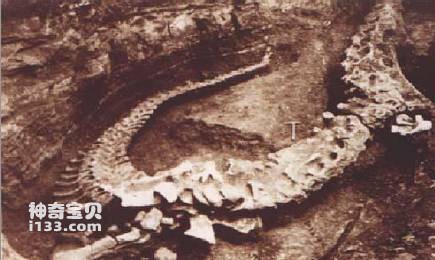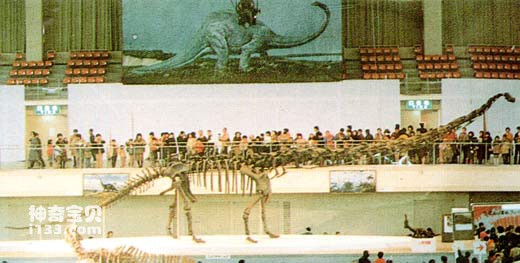In early 1957, the 4th Regiment of the 2nd Detachment of the Geological Survey Division of the Sichuan Petroleum Administration Bureau, led by Xu Jiaren, the leader of the geological team, came to Gulou Mountain in Taihe Township in order to conduct oil and natural gas exploration in the Hechuan Dashiqiao structure. Gulou Mountain is composed of a red rock formation. The mountain is high, steep, and covered with thorns. Geological worker Hou Tengyun was not afraid of difficulties and took the lead when going up the mountain. When he climbed halfway up the mountain, he suddenly found a white stone shining brightly among the red rock formations. He struck it with a geological hammer, and the white stone turned out to be quite hard. He squatted down and took a closer look. The stone looked more and more like animal bones. He immediately realized something and couldn't help shouting: "Come and see, there are dinosaur fossils here!"

Mamenchisaurus
When everyone heard the shouting, they immediately rushed over. After team leader Xu Jiaren observed and determined that it was a dinosaur fossil, he immediately organized the entire team to start digging. Since they did not bring suitable digging tools, in order to ensure the integrity of the fossils, they had to use their hands to remove the rocks around the fossils piece by piece. Some people's fingers were scratched by the rocks, but they did not care because they found dinosaurs. The joy of fossils drives away fatigue and pain.

After a day of excavation, the area where the fossils were exposed became larger and larger, and the difficulties faced by the excavation work became more and more severe. Captain Xu Hesheng came over after hearing the news. After understanding the situation, he immediately assigned technician Tian Xitong, who had just graduated from Northwest University, to organize migrant workers to come and help with the excavation. The excavation work continued for several months, until early May, a complete dinosaur fossil skeleton was finally revealed to people.
The news that a complete dinosaur fossil skeleton was discovered in Hechuan quickly spread throughout Sichuan and even reached the capital Beijing, thousands of miles away. There is an endless stream of people coming to visit, and people from the Institute of Vertebrate Paleontology and Paleoanthropology of the Chinese Academy of Sciences, the Chengdu Institute of Geology, and museums from various places have all sent people to conduct inspections.

After research, scientists determined that the layer where this huge dinosaur was buried was at the top of the Shaximiao Formation in the Chongqing Group of the Jurassic, and the age was about 120 million years ago. It belongs to the sauropod family, which is the largest member of the dinosaur family. It lives in swamps and feeds on plants. After a heated discussion, the members of the excavation team agreed that it should be named after the place where it was found, so the scientists adopted their suggestion and named the dinosaur "Hechuan Mamenchisaurus". The discovery, excavation and research of Mamenchisaurus in Hechuan not only provide precious materials for studying the systematic development of sauropod dinosaurs, but also provide important scientific basis for studying the paleogeography and paleoclimate of the Sichuan Basin.

Later, scientists and paleontologists worked together to put the Hechuan Mamenchisaurus on display. This 22-meter-long behemoth has always been known as China's largest dinosaur. It has also been exhibited in Japan, Hong Kong, Thailand, Singapore and other countries and regions. It has been admired by people from all walks of life and has become a world-famous science popularization star.
animal tags:
We created this article in conjunction with AI technology, then made sure it was fact-checked and edited by a Animals Top editor.